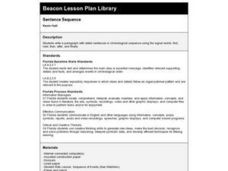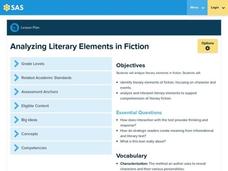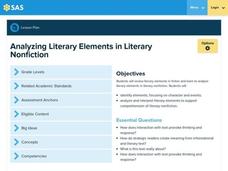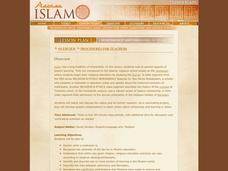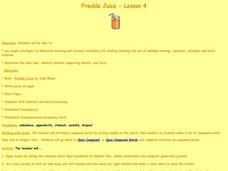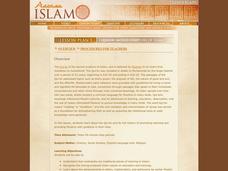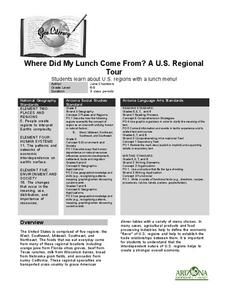Curated OER
Sentence Sequence
Second graders write a paragraph with detail sentences in chronological sequence.
Curated OER
“THE LORAX” by Dr. Seuss
Few children's books convey the message of conservation as well as Dr. Seuss' The Lorax. Read the story aloud, emphasizing the interconnectedness of plants and animals in an ecosystem and discussing different ways people can help...
Channel Islands Film
Santa Cruz Island - Visible Thinking Routines
Visible Thinking Routines are designed to help learners deepen their understanding of what they are learning and enable them to communicate their understanding of concepts to others. Individuals adopt one of these routines to use to...
EngageNY
Contrasting Two Settings (Chapter 6: "Lost Melones/Cantalouples")
Continue working through Esperanza Rising, by Pam Munoz Ryan, by looking into language choices and discussing text-dependent questions. Pupils converse in small groups and as a class about plot, setting, and figurative language. Using...
Pennsylvania Department of Education
Analyzing Literary Elements in Fiction
Young scholars analyze the characters and events in fictional writing. In this literary elements lesson, students study the meaning of the words characterization and fiction. They listen to the story Pigsty by Mark Teague, or any other...
Curated OER
My Brother Sam is Dead: A study of the Revolutionary War
Fifth graders complete an analysis of the Revolutionary War through literature. After "My Brother Sam Is Dead," students create a time capsule containing items that would be relevant during the Revolutionary War. They identify key...
Curated OER
If I Could Have Lived in Another Time or Culture
Third graders develop multi-paragraph compositions. They include an introduction, first and second level support, and a conclusion. They use a variety of sentence structures (e.g., simple, compound/complex) and sentence types (i.e.,...
Curated OER
Class Field Guide to the Sloughs
Students explore how to use field guides to identify wildlife. In this nature lesson students construct their own plant field guide.
Curated OER
Propaganda Techniques
Sixth graders locate examples of persuasive writing. In this persuasive writing lesson students work in a groups to identify and analyze the use of propaganda techniques. Students use newspapers to find editorials, or advertisements,...
Pennsylvania Department of Education
Analyzing Literary Elements in Literary Nonfiction
Fourth graders identify the literary elements of a nonfiction text. In this literary elements lesson, 4th graders read the text Piano Starts Here--The Young Art Tatum and fill in a chart that includes the events from the book....
Curated OER
Establishing a Point of View in Narratives
Fourth graders investigate the concept and take the opportunity to both identify and to construct point of view in narratives. Additionally, 4th graders practice identifying and sequencing main events.
Curated OER
Paint My Counties: Map Coloring the Counties of Arizona
Fourth graders identify the counties of Arizona. In this social studies lesson, 4th graders color a county map of Arizona using the fewest number of colors possible. Students write a persuasive paragraph.
Curated OER
Friendly Patter Poetry
Students create a free from poem on the topic of friendship. They read examples of free form poetry to gather ideas. Through the use of a graphic organizer, students generate a list of friendship characteristics which is used to create...
Curated OER
Teaching a Short Story
Students work in small groups and prepare an analysis of a short story to be presented to their peers. They research the story and create a handout or a visual aid that cites sources of information and summarizes the main points of the...
Curated OER
Character and Plot Development Through Comics
Third graders are introduced to character, plot development, point of view, and tone through the use of comic strips. They, in pairs, identify these four attributes in the comic strip and present their findings to the class.
Curated OER
The Raven: Creator of the Universe?
Young scholars explore biology by researching birds in class. In this raven identification instructional activity, students utilize the Internet to identify the anatomy, habits and habitat of ravens. Young scholars write descriptive...
Curated OER
Scholarship and Learning in Islam
Young scholars explain what a madrasah represents in Islam. Using the Muslim world as an example, they identify and describe two or more centers of learning. They explain the contributions that Muslims have made to science and math and...
Curated OER
Creating Context: The Printing Press as Impetus
Tenth graders examine the invention of the Gutenberg printing press and its effect on society. In groups, they research how much the press enabled various revolutions around the globe. They also identify the causes and effects of each...
Curated OER
Freckle Juice
Pupils analyze a chapter from the assigned book they are reading. In this reading comprehension lesson, students read chapter four from Freckle Juice by Judy Blume, and discuss the main character, Andrew. Pupils complete a...
Curated OER
The Underground Railroad in the I and M Canal Area
Students discuss provocative statements about the Underground Railroad and form opinions. They locate and read a selection on the Internet that either supports of discredits their written opinions. They then read a speech by John Hossack.
Curated OER
Qur'an: Sacred Scripture of Islam
Students discover the strong emphasis Islam puts on education. Using the Internet, they identify advancements in ethics, math and astronomy. They explain the importance of madrasahs, or traditional places of learning in Islam, and...
Curated OER
Where Did My Lunch Come From? A U.S. Regional Tour
Students explore the regions from which their food comes. In this social studies lesson, students identify the different agricultural products that are found in the major regions of the United States. Students create a lunch menu.
Orange County Department of Education
Integrity and a Boy Called Slow
Fifth graders identify the character trait of integrity in the main character, Slow, in "A Boy Called Slow." They participate in a discussion to determine what steps the main character took to earn his new name. Students write an essay...
Curated OER
Sum It Up!!!
Young scholars main goal of reading is comprehension. They encounter one main strategy of summarization. They comprehend that summarization is the process of finding the most important information from a reading. Students must follow...
